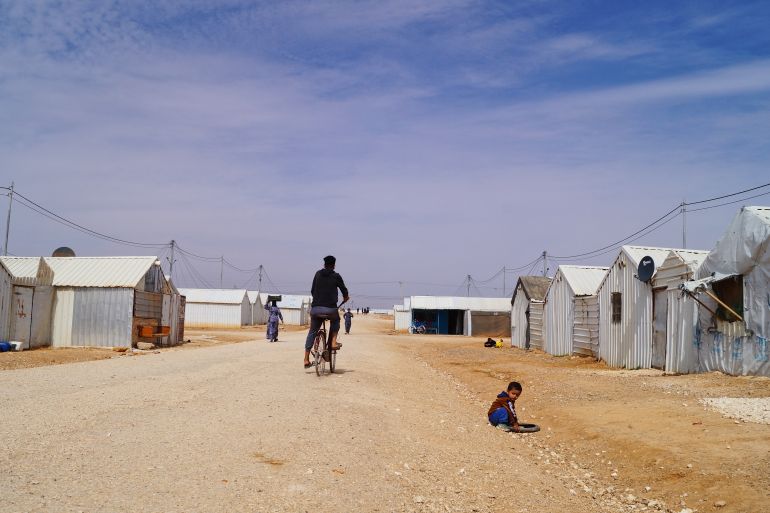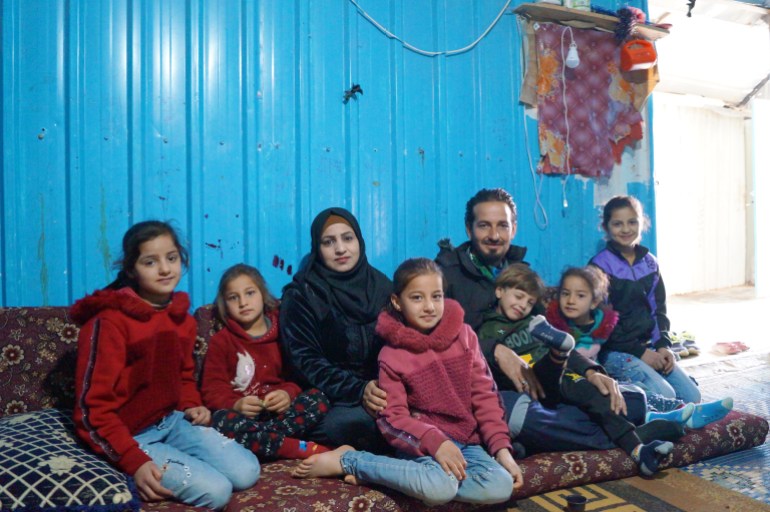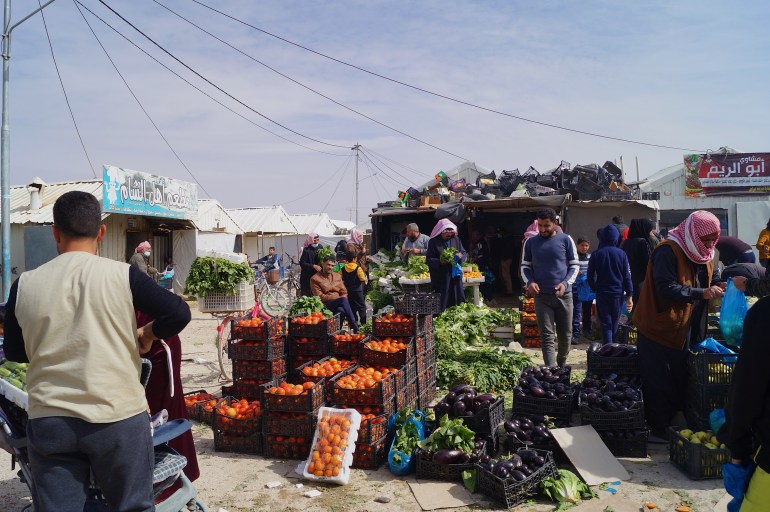A life of isolation for Syrian refugees in Jordan’s Azraq camp
Opened in 2014, the remote refugee camp was built in response to overcrowding at Zaatari, Jordan’s largest facility for Syrian refugees.

Azraq, Jordan – Uniform rows of white caravans plotted neatly in the desert’s empty expanse are home to nearly 38,000 Syrian refugees.
They are the victims of the now 11-year-long Syrian war who continue to wait at Jordan’s Azraq camp, their futures still uncertain and their livelihoods still dependent on donors’ generosity.
Keep reading
list of 4 itemsFor Syrian survivors, Russia’s tactics in Ukraine eerily similar
Syria’s Assad visits UAE in first trip to Arab state since 2011
Syria constitutional talks fail again in Geneva
For thousands of children born and raised in the camp, the arid landscape is the only back yard they have known.
“Can you take us outside,” asked 11-year-old Asmaa Fawaz Barhu who came to Azraq camp when she was five.
“‘Since we have been here, we have not seen trees, we have not seen animals,’ my children say,” Asmaa’s mother, Zahra Ghareeb al-Daher, told Al Jazeera. “‘Are we going abroad, going to travel to Germany?’ they ask me.”
Zahra’s seven children, two of whom were born in the camp, have not left the premises since they arrived in 2016, she said.
Residents must present a work permit to leave, which only 30 percent of the camp’s working-age population holds, according to the United Nations High Commissioner for Refugees (UNHCR) Jordan spokeswoman, Lilly Carlisle. They are occasionally granted “leave permits”, which are valid for on average a week with repercussions for those who overstay.
Opened in 2014, the camp was designed to address the challenges that emerged during the informal growth of Zaatari camp, Jordan’s largest for Syrian refugees. However, the top-down system of management, high security, and remote location have left Azraq commonly referred to as the “least desirable” of Jordan’s two main camps for Syrian refugees.
It hosts “Village 5”, a secured area where nearly 10,000 Syrians are kept on the premises for “reasons of safety and national security”, noted Carlisle, the camp’s stringent security protocols largely attributable to the prison-like compound.
Azraq has never reached even half its maximum capacity of 120,000, the majority of refugees choosing to bear the high costs of living outside its perimeters.
But for some, there is no alternative. “What are we going to do?” Zahra said. “Life is very hard out there. We won’t be able to afford it.”

Price of freedom
Nearly 80 percent of the 673,957 registered Syrian refugees in Jordan live in urban areas, where UNHCR’s breadth of services, notably housing and healthcare, are far less accessible – posing great challenges for a population whose work opportunities are extremely limited.
Syrians are limited to sectors open to non-Jordanians such as agriculture, sales, and construction, and must pay the non-insured Jordanian rate for all healthcare services, prices out of reach for most of the population, Carlisle said.
Ahlam Ibrahim and her husband, Riad Ahmed, left Azraq camp in 2019 when she was pregnant with her sixth child.
“We were not able to live there,” Ahlam told Al Jazeera, referencing the camp’s prison-like atmosphere.
They sell their monthly World Food Programme (WFP)-distributed food stamps to afford rent in their small apartment in Jabal Hussein refugee camp, a nearly 70-year-old camp for Palestinian refugees in the kingdom’s capital, Amman.
Riad explained how they receive about 150 Jordanian dinars ($212) monthly in food vouchers, which they can sell for about 130 dinars ($183) to traders in the Zaatari camp, who then buy products from its supermarket and resell them in the surrounding cities. This covers their 100 dinars ($141) monthly cost of rent, he told Al Jazeera.
Sometimes, in the months Riad finds work, they are able to save their food stamps. But during most of the year, Ahlam said, she relies on her neighbours’ help to feed her children.
Still, for Riad and Ahlam, the high costs of living outside the camp are worth it. They said their children are learning better in Jordan’s public schools, the food they can access is fresher, and their apartment is easier to heat than the camp’s tin caravan.
Syrian refugees living in urban areas such as Riad and Ahlam were hit especially hard by the pandemic-induced economic downturn, which forced thousands to decide their quality of life in Jordan was no longer sustainable.
In 2021, as unemployment rates in the kingdom rose to unprecedented levels, about 5,800 Syrian refugees in Jordan voluntarily returned to Syria, according to UNHCR figures.
Others chose to return or remain in the camps for more easily accessible UNHCR-provided services. “The standards of living in the camp are high,” said Carlisle. “We have seen more people staying in the camps because they don’t have to pay for rent, food, water, etc.”
Zahra said in the camp at least “I have a door and I have my family. It is safe.”

‘There is nothing’
In March 2011, pro-democracy demonstrations followed by Syrian President Bashar al-Assad’s deadly crush of the dissent ignited a civil war, which, fuelled by proxy warfare, has raged in Syria now for 11 years.
“My house was completely destroyed, my clothes, my jewellery, everything is destroyed,” said Zahra. “I hope to return, but at the same time, what am I going to return to? There is nothing.”
The majority, 96 percent, of Syrian refugees do not see themselves returning to Syria in the next year, a UNHCR survey conducted in October 2021 found.
“It’s now been over a decade that Jordan has been hosting over 1.3 million Syrians,” Jordan’s Planning Minister Nasser Shraideh told Al Jazeera. “We’ve been sharing our resources, our public services, our infrastructure.”
“We hope for a political resolution for the Syrian issues, which would allow Syrians to return back to their homeland, but until then, the government of Jordan will do its best to accommodate them,” Shraideh added.
A public opinion survey released at the start of the year found growing fatigue in the Jordanian host community’s attitudes towards supporting refugees. About 39 percent of respondents said the government’s refugee response was “oversufficient” – a number more than triple that recorded in October 2020.
The survey also reported a growing consensus that “refugees get more help than Jordanians”. An overwhelming 81 percent of survey respondents said Jordanians have been affected more severely by the pandemic’s economic repercussions than refugees.
“Jordanians have been quite welcoming towards refugees,” Shraideh said. “I hope that the rising tensions from the economic hardships we are witnessing because of the pandemic’s repercussions will not jeopardise this.”
Donor fatigue
The protracted nature of the Syrian conflict coupled with competing global crises has contributed to increasing donor fatigue, Senior External Relations Officer at UNHCR Jordan Francesco Bert told Al Jazeera.
Bert noted while UNHCR has managed to sustain its level of services, its NGO partners are “struggling to keep up”. In September last year, the WFP alerted 110,000 Syrian refugees in Jordan that their food assistance would end in October.
“The first year we were here [at Azraq camp] there were more services,” Zahra said. She referred to items such as food packages her family would receive from smaller charities during their first years in the camp.
“We are nine people so when we only depend on the WFP vouchers, sometimes it can be a struggle. So the small charities used to help us,” she said.
Shraideh referred to the pressures a decade of hosting Syrian refugees have placed on Jordan’s resources and job opportunities. “The international community should raise the level of support for Syrian refugees in Jordan,” he said, in reference to the increasing levels of donor fatigue.
The humanitarian response to the Syrian crisis is “at the crossroads to transition to a different approach” as more development actors enter the fold “we need to look beyond an annual cycle”, Bert said.
“We are ultimately facing a challenge that every humanitarian organisation has to go through. At what point can you pass over your services to development actors? We cannot take Jordanian hospitality for granted when it comes to refugees,” he added, but, “we would like to see more sectors becoming open for refugees.”
Last year, Jordan issued a record 62,000 work permits to Syrians. In July 2021, the government, in cooperation with UNHCR, opened work permits for Syrians in all sectors open to non-Jordanians, which had previously been limited to agriculture, construction, and manufacturing.
Bert also noted while an “interesting entrepreneurship” has developed in the camps, the restrictions on movement have limited its ability to flourish. “We would like to see Syrians able to move more freely in and out of the camps and more opportunities for Syrians to be able to work in the surrounding community.”
However, Shraideh said, “It would be quite challenging for the economy to produce additional jobs that are much needed for Jordanians. We [the Jordanian government] need to address the rising challenges for Jordanians while trying to do our best for Syrians.”
But the “vast majority” of Syrian refugees will be in Jordan for years to come, Bert said.
“Years from now, the idea for us [UNHCR] is that refugees will not be singled out as per their legal status, but rather be included in the national programme,” he noted, adding the services could be made not just for the benefit of refugees but for both populations.
“I want my girls to have a better future,” Zahra said. “At least, God willing, they can finish their education and then they can follow their own dreams. But for my dreams, don’t ask me because my dreams are over. Now it’s their turn.”